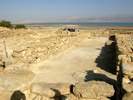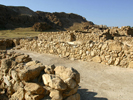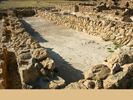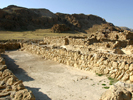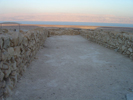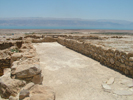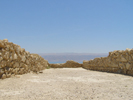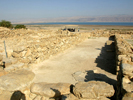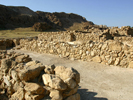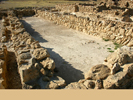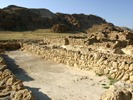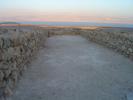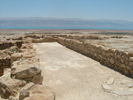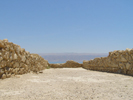Assembly Hall

Introduction
At the southern section of the settlement, there is a large rectangular room, roughly 72 by 15 feet (22 by 4.5 meters), identified by De Vaux as an assembly hall. It is located adjacent to a room that has been identified as a pantry which was filled with roughly one thousand serving utensils and vessels. Both De Vaux and Magness maintain that the large hall functioned as a dining room throughout the community’s use of the Qumran site, though Magness argues that after the earthquake of 31 BCE, a second floor was added and the dining hall transferred there. The sloping floor of the room, and a water channel opening through the doorway of the western wall would have facilitated cleaning, as would be desirable in a dining area, especially one that would be used for other purposes as well.
The identification of this room as a dining hall is advanced by the discovery of a miqveh (ritual bath) directly outside the room. The scrolls indicate that members were required to immerse themselves in water in order to purify themselves prior to entering the hall for meals or prayer (see Ritual Purity). Our understanding of the communal meetings and meals associated with this assembly hall has been shaped by information provided in some of the main sectarian texts among the Dead Sea Scrolls.
Communal Meals
A number of the scrolls make reference to communal meals, presided over by a kohen (priest), who would recite the blessing over bread and wine at the start of the meal. For example, the Community Rule (1QS) reads:
They shall eat, pray, and deliberate communally. Wherever ten men belonging to the society of the Yahad are gathered, a priest must always be present. The men shall sit before the priest by rank, and in that manner their opinions will be sought on any matter. When the table has been set for eating or the new wine readied for drinking, it is the priest who shall stretch out his hand first, blessing the first portion of the bread or the new wine. In any place where is gathered the ten-man quorum, someone must always be engaged in study of the Law, day and night, continually, each one taking his turn. (1QS 6:2-7)
The stipulation that ten men are needed for a quorum is similar to rabbinic requirements for a minyan, a gathering of ten men that is needed for the recitation of certain Jewish prayers. More generally, Lawrence Schiffman has observed that the rituals associated with meals at Qumran are similar to those that would have been practiced by other Jews at the time. Other scholars have proposed that the communal meal was more than an ordinary meal with standard ceremonial practices. It has been suggested that the sect saw their meals as replacements for sacrificial meals in the Jerusalem Temple, since they had rejected participation in the established Temple service. It has also been suggested that these “sacral” meals were intended as a depiction or projection of the meal that was expected to take place in the presence of the Messiah in the end of days. In both the above passage from 1QS and in the eschatological 1QSa (the Messianic Rule), the priest or priest-Messiah is described as blessing and praying prior to the consumption of the meal. (See 1QSa 2:17b-22).
Community Meetings
The procedures regulating the Qumran community are outlined in two main compositions: the Community Rule (1QS; also 4Q255-264) and the Damascus Document (CD; also 4Q265-73, 5Q12, 6Q15). Despite differences between these works, they are useful sources of information about the structure and regulations of the Qumran Community. For admissions procedures, including communal registration of property, see Admission to the Community; for rules and methods of their enforcement, see Community Discipline.
Both the Community Rule and the Damascus Document indicate that the members of the Community participated in general meetings at which rank and conduct played central roles. As in the case of the communal meals, a priest presided over each meeting:
- This is the rule for the session of the general membership, each man being in his proper place. The priests shall sit in the first row, the elders in the second, then the rest of the people, each in his proper place. In that order they shall be questioned about any judgment, deliberation or matter that may come before the general membership, so that each man may state his opinion to the party of the Yahad. (1QS 6:8-10)
According to the Damascus Document, a priest needed to be present at any gathering of ten individuals (CD 12:22b-13:2), and every member of the congregation was assigned a permanent position in a community assembly, according to his level of learning or wisdom (CD 14:8-12a).
A substantial number of regulations governed procedure and behavior at the community meetings. We see in the Community Rule:
- None should interrupt the words of his comrade, speaking before his brother finishes what he has to say. Neither should anyone speak before another of higher rank. Only the man being questioned shall speak in his turn. During the session of the general membership no man should say anything except by the permission of the general membership, or more particularly, of the man who is the Overseer of the general membership. If any man has something to say to the general membership, yet is of a lower rank than whomever is guiding the deliberations of the party of the Community, let him stand up. He should then say, ‘I have something to say to the general membership.’ If they permit, he may speak. (1QS 6:10-13)
Other regulations specify punishments for absence from communal meetings, and for various offenses pertaining to behavior at meetings, including spitting, sleeping, interrupting another member of the sect, and non-attendance. Strict rules of conduct applied outside of meetings as well, with disciplinary measures recorded for such violations as losing one’s temper, exposing one’s private parts, and gesturing with the left hand during conversation. See Community Discipline.
More Info
- Charlesworth, James H. “Community Organization in the Rule of the Community.” Pp. 133-36 in Encyclopedia of the Dead Sea Scrolls, Vol. I. Eds. Lawrence H. Schiffman and James C. Vanderkam. Oxford: Oxford University Press, 2000.
- Lawrence H. Schiffman, The Eschatological Community of the Dead Sea Scrolls (Society of Biblical Literature Monograph Series, 38), Scholars Press, Atlanta 1989
- Lawrence H. Schiffman, Sectarian Law in the Dead Sea Scrolls: Courts, Testimony, and the Penal Code (Chico, CA: Scholars Press, 1983).
- Charlotte Hempel. “Community Structures in the Dead Sea Scrolls: Admission, Organization, Disciplinary Procedures.” In The Dead Sea Scrolls after Fifty Years: A Comprehensive Assessment, ed. Peter W. Flint and James C. VanderKam, 2:67-92. Leiden: Brill, 1998-1999.
- Aharon Shemesh, “Expulsion and Exclusion in the Community Rule and the Damascus Document,” Dead Sea Discoveries 9/1 (2002): 44–74.
